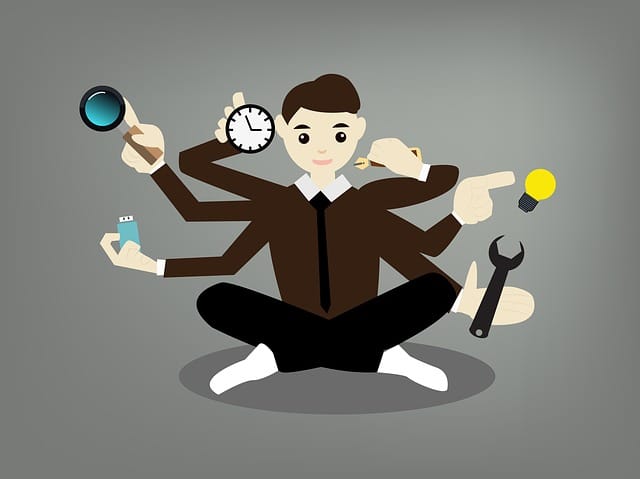In today’s fast-paced work environment, many of us pride ourselves on our ability to multitask. However, research shows that multitasking can actually hinder our productivity and focus. By understanding the dangers of dividing our attention, we can reclaim our focus at work and unlock our true potential. Embracing single-tasking not only enhances our efficiency but also leads to greater job satisfaction. Join us as we explore practical techniques and strategies to cultivate a more focused, distraction-free workspace.
Understanding the Dangers of Multitasking
In today’s fast-paced work environment, many individuals pride themselves on their ability to multitask. However, this seemingly efficient approach can lead to significant drawbacks. Understanding the dangers of multitasking is crucial for reclaiming your focus at work.
- Reduced Productivity: Studies show that multitasking can lower overall productivity by up to 40%. When you juggle multiple tasks, your brain struggles to switch gears effectively, resulting in time lost during transitions.
- Increased Stress: Multitasking often creates feelings of overwhelm. Simultaneously handling various responsibilities can elevate stress levels, making it harder to concentrate and perform well.
- Impaired Memory Retention: According to research, multitasking negatively affects memory. When you spread your attention across several tasks, you may find it challenging to retain crucial information, which can hinder decision-making and problem-solving.
- Lower Quality of Work: Focusing on multiple tasks can compromise the quality of your output. Instead of delivering your best work, multitasking can lead to careless mistakes and reduced attention to detail.
- Negative Impact on Creativity: Multitasking can stifle creativity by limiting deep thinking and reflection. A scattered focus hampers your ability to innovate and generate new ideas.
By recognizing these dangers, you can start embracing a focused approach to work and enhance your overall productivity. Remember, achieving clarity and quality often outweighs the perceived benefits of multitasking!
You can buy books about Multitasking from Amazon by clicking here.

The Science Behind Focus and Productivity
Understanding the link between focus and productivity is crucial in combating the drawbacks of multitasking. Research shows that our brains function much better when we concentrate on one task at a time. Here are some compelling insights:
- Cognitive Load: Multitasking increases our cognitive load, which can lead to decreased efficiency. When handling multiple tasks, the brain expends more energy, leading to mental fatigue.
- Task-switching costs: Transitioning from one task to another can consume up to 40% of our productive time. The brain requires time to refocus, which hinders progress on all fronts.
Focus vs. Multitasking: A Comparison
| Feature | Focus (Single-Tasking) | Multitasking |
|---|---|---|
| Cognitive Energy Usage | Lower energy consumption | Higher energy consumption |
| Efficiency | Increased productivity | Decreased productivity |
| Mental Clarity | Clear thought processes | Confused and scattered |
| Quality of Work | Higher quality outcomes | More mistakes |
By recognizing the science behind focus and productivity, we can appreciate the importance of single-tasking. Instead of spreading ourselves thin through multitasking, we empower ourselves to achieve remarkable results with a clearer mind. Commit to focusing on one task at a time, and watch your efficiency soar!
Realizing Your Work Patterns
To regain focus and optimize productivity, it’s essential to recognize your work patterns, especially regarding multitasking. By identifying how you manage tasks, you can make informed adjustments that enhance your performance. Here are a few key points to consider:
- Track Your Tasks: Maintain a simple log of your daily activities. Note when you switch between tasks or juggle multiple responsibilities at once. This insight reveals how much time you devote to multitasking versus focused work.
- Understand Your Peak Hours: Identify when you’re most alert and productive. Focus on single-tasking during these high-energy periods. This way, you can maximize your output without the distractions that multitasking brings.
- Assess Your Workflow:
- Linear vs. Non-linear: Do you prefer a step-by-step approach (linear) or bounce around tasks (non-linear)? Acknowledging your natural inclination can help you structure your work to favor concentration.
- Recognize Triggers: What prompts your multitasking habits? Is it incoming emails or phone notifications? Understanding these triggers allows you to create strategies to minimize distractions.
By recognizing and adjusting your work patterns, you can transition from multitasking to a more focused work style. This shift not only increases productivity but also contributes to a sense of accomplishment and satisfaction in your workday. Focus on your unique patterns today and embrace the benefits of single-tasking!
Benefits of Single-Tasking
Single-tasking emerges as a powerful antidote to the distractions of multitasking. By concentrating on one task at a time, you unlock a range of benefits that can significantly enhance your productivity and overall work satisfaction. Here’s why embracing single-tasking can be transformative:
- Enhanced Focus: When you commit to a single task, your mind can delve deeply into your work. This concentrated effort leads to better quality outcomes.
- Increased Efficiency: Research shows that multitasking can reduce productivity by up to 40%. In contrast, single-tasking allows you to complete tasks faster, freeing up time for additional responsibilities or projects.
- Improved Retention: Focusing on one task at a time helps your brain to retain information better. This retention aids in learning and applying new skills effectively.
- Reduced Stress Levels: Juggling multiple tasks generates unnecessary pressure. Single-tasking fosters a calmer mindset, which decreases stress and anxiety.
- Enhanced Creativity: By giving your mind the space to breathe, single-tasking encourages creative thinking. You’ll find that solutions to problems emerge more readily when distractions fade away.
Here’s a quick comparison of multitasking vs. single-tasking benefits:
| Aspect | Multitasking | Single-Tasking |
|---|---|---|
| Focus | Fragmented | Deep and consistent |
| Efficiency | Decreased | Increased |
| Stress Levels | Higher | Lower |
| Creativity | Limited | Enhanced |
By adopting single-tasking, you’re bound to experience these advantages, reclaiming your focus and ultimately elevating your work performance. Embrace this shift today!

Techniques to Improve Focus
Improving your focus is essential to counteract the distractions often caused by multitasking. By adopting specific techniques, you can regain control over your attention and enhance productivity. Here are several effective strategies to help you stay focused:
- Prioritize Tasks: Break your work into manageable tasks and rank them by importance. Tackle high-priority items first to maintain momentum throughout the day.
- Time Blocking: Allocate set blocks of time for individual tasks. For example, dedicate 25 minutes to work on a project followed by a 5-minute break. This concentrates your efforts and reduces the urge to multitask.
- Pomodoro Technique: Similar to time blocking, this method uses timers to break your work into intervals (typically 25 minutes) followed by short breaks. This creates urgency and keeps distractions at bay.
- Limit Distractions: Identify what typically pulls your attention away from work. Turn off notifications, close unnecessary tabs, and create a quiet environment to minimize interruptions.
- Mindfulness Practices: Take a moment to practice mindfulness. Techniques like deep breathing or meditation can center your thoughts and enhance your awareness, making it easier to focus.
By incorporating these techniques, you’ll find it easier to shift away from multitasking and embrace a more productive work style. Remember, the key to success is to single-task and prioritize your focus!
Creating a Distraction-Free Workspace
When it comes to enhancing focus, creating a distraction-free workspace is essential. Multitasking often leads to fragmented attention, and a cluttered environment can contribute to this problem. Here are some effective strategies to cultivate a workspace that promotes concentration and reduces the temptation to multitask:
- Declutter Your Space: Start by removing unnecessary items from your desk. A clean, organized desk helps to minimize distractions and allows you to focus solely on the task at hand.
- Minimize Digital Distractions: Silence notifications on your phone and computer. Consider using apps that temporarily block social media and other distracting websites while you work.
- Establish a Dedicated Work Zone: If possible, designate a specific area in your home or office solely for work. This physical separation helps signal your brain that it’s time to concentrate, making it easier to resist the allure of multitasking.
- Control Noise Levels: Invest in noise-canceling headphones or play white noise to drown out background sounds. This can create a soothing atmosphere conducive to focused work.
- Personalize Your Environment: Incorporate elements that inspire you, such as plants or motivational quotes. A workspace that resonates with you can enhance your mood and focus.
By prioritizing a distraction-free workspace, you empower yourself to improve productivity and shift away from the lengthy habit of multitasking.
Setting Clear Priorities and Goals
Setting clear priorities and goals is crucial for overcoming the pitfalls of multitasking. When you outline your objectives, you create a roadmap that guides your work and reduces the urge to juggle multiple tasks simultaneously. Here’s how you can effectively prioritize:
- Identify Your Major Tasks: List the most important tasks for the day. Focus on deadlines, significance, and expected outcomes.
- Use the Eisenhower Matrix: Categorize tasks by urgency and importance:
- Urgent and Important: Do these tasks immediately.
- Important but Not Urgent: Schedule these tasks for later.
- Urgent but Not Important: Delegate if possible.
- Neither Urgent nor Important: Eliminate these tasks.
- Set SMART Goals: Ensure your goals are Specific, Measurable, Achievable, Relevant, and Time-bound. This clarity helps you stay focused, reducing the inclinations towards multitasking.
- Break Tasks into Smaller Steps: Dividing larger projects into manageable chunks helps maintain focus. It also provides a sense of accomplishment as you complete each step.
By clearly prioritizing your work, you shift your mindset away from multitasking and towards effective single-tasking. This approach not only increases productivity but also enhances overall satisfaction with your work. Thus, making intentional decisions about where to direct your energy is essential for a focused workflow.

Embracing Breaks and Downtime
In our quest for productivity, we often overlook the essential role of breaks and downtime. Quite surprisingly, embracing regular breaks can significantly boost focus, especially when battling the challenge of multitasking. Here’s why structured downtime is invaluable:
- Mental Restoration: Taking breaks refreshes your mind, allowing you to return to tasks with renewed energy and focus.
- Enhanced Creativity: Downtime encourages creative thinking, enabling innovative solutions that multitasking often stifles.
- Improved Performance: Studies show that working in short bursts followed by breaks can lead to sustained performance without the fatigue that multitasking creates.
Suggested Break Techniques
To make the most of your breaks, consider:
- The Pomodoro Technique: Work for 25 minutes, then take a 5-minute break. After every four sessions, indulge in a longer break of 15-30 minutes.
- Mindful Breathing: Take a few minutes to breathe deeply, which helps in reducing stress levels and improving focus.
- Physical Movement: Engage in a brief walk or stretching exercises to get your blood flowing and stimulate your mind.
By consciously taking breaks, you enhance your efficiency and create a healthier work environment. Remember, downtime is not a luxury; it’s a vital component in the fight against multitasking! Embrace it, and watch your focus and productivity soar.
Tools and Apps to Enhance Focus
In our fast-paced work environment, embracing tools and apps designed to enhance focus can redefine how we approach productivity. While multitasking often leads to scattered thoughts and diminished output, these innovative resources encourage single-tasking and help reclaim your attention.
Here’s a list of effective tools that can transform your work habits:
- Focus@Will: This app provides music scientifically optimized to improve concentration and reduce distractions.
- Forest: By planting virtual trees, you foster focus. The longer you stay on task, the more your forest grows, promoting accountability.
- Trello: Organize your tasks visually to avoid multitasking. Break projects into specific cards, ensuring clear focus on one task at a time.
- RescueTime: This app tracks your online activity and habits, helping you identify distractions and create a focused work schedule.
Comparison of Tools
| Tool | Focus Enhancement Mechanism | Ideal User |
|---|---|---|
| Focus@Will | Curated music for concentration | Creatives and thinkers |
| Forest | Gamifies focus through virtual tree planting | Gamers and taskers |
| Trello | Visual task management | Project managers |
| RescueTime | Usage analytics for better time management | Everyone seeking improvement |
In summary, integrating these tools into your daily routine can significantly reduce the allure of multitasking, encouraging a culture of focus and productivity. Embrace these resources and reclaim your ability to concentrate deeply on your important tasks!
Cultivating Mindfulness at Work
Cultivating mindfulness at work plays a vital role in combating the pitfalls of multitasking. When we practice mindfulness, we sharpen our focus, enhance our productivity, and foster a clearer mental space. Here are some effective strategies to embrace mindfulness:
- Start your day mindfully: Dedicate a few minutes each morning for deep breathing or meditation. This simple act sets a positive tone for the day ahead.
- Engage in single-tasking: Commit to focusing on one task at a time, rather than succumbing to the urge to multitask. This approach boosts concentration and quality.
- Take mindful breaks: Step away from your desk every hour for a short, focused break. During this time, stretch or go for a quick walk, allowing your mind to reset.
- Practice active listening: When conversing with colleagues, focus entirely on the discussion. This cultivates stronger relationships and encourages collaboration without the distraction of multitasking.
- Limit distractions: Create a conducive work environment by silencing notifications and organizing your workspace. A decluttered area promotes a more mindful state.
Implementing these mindfulness strategies will not only help you avoid multitasking but will also enhance your ability to articulate your thoughts and perform at your best. Remember, being mindful means giving your undivided attention to the present moment, which ultimately leads to greater satisfaction and fulfillment at work.

Making a Commitment to Stay Focused
Staying focused in today’s fast-paced work environment requires a strong commitment, especially when the temptation of multitasking lurks around every corner. To enhance your productivity and reclaim your attention, consider the following strategies:
- Set Intentions Daily: Begin each day by identifying your most important tasks. Commit to focusing on one task at a time, which minimizes the urge to switch between projects.
- Practice Self-Reflection: At the end of each week, evaluate your focus levels. Ask yourself:
- Did I stick to my commitments?
- How often did I revert to multitasking?
This reflection reinforces your dedication to maintaining focus.
- Establish Boundaries: Communicate with colleagues about your focus hours. Let them know when you prefer to remain undisturbed, thus creating a supportive environment that discourages multitasking.
- Hold Yourself Accountable: Share your focus goals with a trusted colleague or friend who can support you. Check in regularly to discuss your progress.
- Visual Reminders: Post motivational quotes or images in your workspace to inspire commitment to focus habits daily.
Embracing these techniques not only cultivates a strong commitment to staying focused but also transforms your approach to work. Remember, breaking free from the habit of multitasking opens doors to greater productivity, creativity, and personal satisfaction!
Frequently Asked Questions
Why is multitasking considered detrimental to productivity?
Multitasking is often seen as a way to increase productivity, but it can actually hinder our efficiency. When we switch between tasks, our brains take time to refocus, leading to cognitive overload. This scattered attention can result in errors and lower quality work. Instead of accomplishing several tasks at once, multitasking can reduce our overall productivity. By focusing on one task at a time, we can complete work more efficiently and with greater accuracy.
How can I start to focus better at work?
To improve your focus at work, begin by creating a designated workspace free from distractions. Establish a routine that prioritizes your most important tasks, and use techniques like the Pomodoro Technique, which encourages short bursts of focused work followed by breaks. Additionally, limit your exposure to notifications from your phone or computer during work periods. Practice mindfulness or meditation to enhance your concentration skills, gradually training your brain to stay focused on the task at hand.
What are some techniques to improve my concentration?
Improving concentration can be achieved through various techniques. Start by setting specific, achievable goals for each work session. Use time management tools, like timers, to allocate periods for focused work while scheduling timely breaks. Incorporating meditation or deep-breathing exercises into your day can also help clear your mind and enhance focus. Finally, consider reducing background noise or using instrumental music to help create a conducive work environment.
How does single-tasking benefit my mental health?
Single-tasking not only enhances productivity but also has significant benefits for mental health. By focusing on one task at a time, you can reduce feelings of overwhelm and anxiety that often accompany multitasking. This practice fosters a sense of accomplishment as you complete tasks more efficiently, boosting your confidence and motivation. Moreover, single-tasking promotes a state of flow, allowing you to engage deeply with your work, which can be fulfilling and reduces stress.
Can technology help me to stop multitasking?
Absolutely! Technology can be a powerful ally in combating multitasking. Consider using apps designed to block distractions, manage tasks, and set reminders. Tools like project management software can help you prioritize and organize tasks effectively, allowing you to focus on one item at a time. Additionally, leveraging features like ‘Do Not Disturb’ on your devices during work hours can significantly minimize interruptions, empowering you to maintain your focus.
